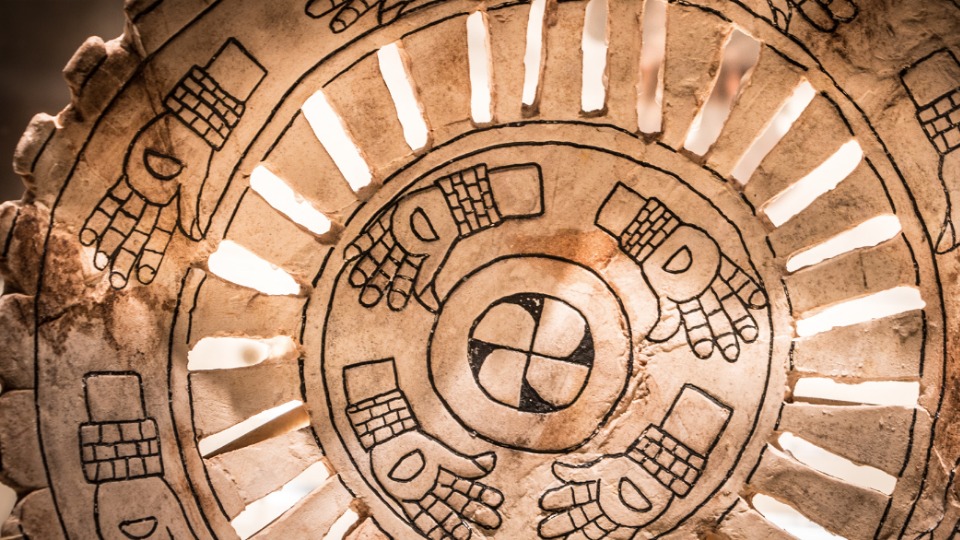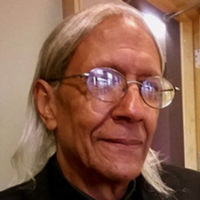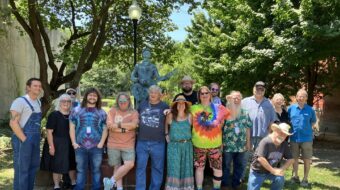
Stunning and staggering is the recent book Recovering Ancient Spiro: Native American Art, Ritual, and Cosmic Renewal. To begin with, this review is directed at all Americans in general, but to all Native Americans in particular, because Spiro and other ancient sites are mostly unknown. This volume of art and essays covers not only the magnificent Spiro site in Oklahoma; it also provides invaluable thought-provoking insights into the glorious, but little known, history of the great civilizations of ancient Indigenous Eastern North America, civilizations now touted as equal to those of the Aztecs and Mayas.
Spiro, located in southeastern Oklahoma on the Arkansas River, to this day holds the distinction of being the only known ancient site in North America where thousands upon thousands of extraordinary artifacts and ritual objects from across the Mississippian world, and beyond, have been found. They were amassed in a hollow chamber named the Spirit Lodge, approximately 16 feet wide and 16 feet high inside a major earthwork. Some of the items were from as faraway as California and the Valley of Mexico. 
These ancient civilizations were, for their time, among the greatest and most brilliant in the entire world. There were millions upon millions of Indigenous inhabitants of these ancient polities. Their civilizations were very advanced but are now largely forgotten.
These cultures, which flourished from 800-1600 C.E., are called Mississippian because some of their first cities and mounds were found along the Mississippi River and in the Mississippi River Valley. Each of these cities, having several thousand to hundreds of thousands of inhabitants, had their own surrounding communities, “suburbs,” and political structures. These cosmopolitan metropolises were typically larger than were places like London or Paris at the same time. This was a continental area that was a paradise, a veritable Eden. The earth was bountiful, there was no disease, the populations were well fed, and warfare was largely preempted by extensive trading activities.
Spiro is considered by many scholars to have been at one time the single most powerful political and cultural entity in North America, the location of a preeminent ritual center. It was looked upon as a sacred geographical area and also as the focal point of an immense cultural exchange that reached as far as Canada in the north and Mexico to the south. There was found at Spiro obsidian from the Valley of Mexico, beads from the Sea of Cortez, copper from the Great Lakes, and engraved shells from the Florida Keys. Also, sacred items from the Cumberland River area of Middle Tennessee and the South Appalachian region have been found at the site.
This book, recognizing all of these far flung connections, edited by Eric D. Singleton, curator of Ethnology of the National Cowboy & Western Heritage Museum, and F. Kent Kelly III, professor of anthropology and author at Texas State University, traverses the sands of time with the art and history of the ancient Spiro site while making contemporary connections to other ancient centers throughout Eastern America. Interspersed in the volume is the art of current Indigenous craftspeople who are the descendants of the ancient cultures. They are among a list of 26 contributors to this stellar work.
The publication also had the support of multiple museums, including the Chickasaw Cultural Center, National Museum of the American Indian, and the Museum of Native American History, along with other institutions and individual contributors. Singleton and Kelly, in producing the book, also sought the permission of the Caddo Nation and the Wichita and Affiliated Tribes to produce the volume. They worked with tribal artists, tribal members, and elders to make the book possible, along with the support of Indigenous nations across Oklahoma and the Southeast.
The Spiro site is believed by most scholars to have been established by Caddo speakers and to have functioned for at least 500 years. Spiro itself goes back at least 1,200 years.

Also to be noted is the extraordinary population decline over the intervening centuries. For example, in the 18th century, the Wichita are said to have numbered over 200,000, with some single population centers, indeed cities, numbering over 20,000 inhabitants each. By 1937, there were only 100 Wichita listed in official records. Today, there approximately 3,000. The Caddo are estimated to have numbered 250,000 at the same time; there are now 6,000 recorded Caddo. It would have taken a huge population to construct the Spiro Mounds, the central part of the site.
The tribal artists whose works are showcased in the volume are from the Caddo, Cherokee, Muscogee Creek, Chickasaw, Potawatomi, Wyandot, and Seminole Nations. Also, profusely presented throughout the work is the amazing art of the Spiro people.
This writer became aware of Recovering Ancient Spiro by happenstance through a colleague, Dr. Arthur Cushman, who, with a lifelong interest in and prodigious knowledge of ancient Indigenous history, obtained a copy while attending the exhibition “Spiro and the Art of the Mississippian World” recently held at the Birmingham Museum of Art in Alabama.
The quality, quantity, and variety of items recovered at Spiro is staggering. What is even more stunning is that the artifacts came from all over North America. Thousands upon thousands of artifacts, crafted in many different mediums, are in the images of people, deities, animals, and mysterious composite beings.
The narrative of Spiro as told in the volume is not confined to the past or concentrated solely on art. It is also presented as part of the artistry of today’s Indigenous peoples, who are the descendants of the ancient Mississippian sovereignties. The cultural artistic tradition continues.
An abundance of great cities
Great cities abounded in the ancient Native America, with cities spread across the eastern half of North America, in the Midwest, and throughout the Southeast. Their inhabitants shared a overlapping political and religious ideologies. The two great foundations of the Mississippian civilizations were generosity and bravery. It is now speculatively thought that these great civilizations were not the work of just one people, but of a combination of tribal peoples working together.
Still, most Mississippian cities had their own distinct features. Spiro stands out as being a kind of ceremonial center that suggests religious pilgrimages and prodigious trading contacts being made periodically, judging by the staggering number of artifacts from all over North America found there.
When the European explorers first landed on the shores of North America, they had no idea of what they would encounter. The unique cultures they confronted were mostly unlike any previously seen. Yet, only a very few saw the grandeur of the once great cities. Mostly they gazed upon the earthen ruins of the once populous urban centers. Just imagine how history could have been so markedly different, how the landscape would have looked so stunningly distinct with great cities in every direction surrounded by veritable suburbs composed of innumerable towns, villages, hamlets, and farmsteads. Vast ceremonial complexes covered the eastern half of the continent from the Great Lakes to the Gulf of Mexico and from the Atlantic Coast to the edge of the Great Plains, which is where we find ancient Spiro.
But before proceeding further to discuss Spiro, there is a bit more to be said about the ancient cultures represented by that brilliant civilization. The Mississippian civilizations were urban centers composed of huge numbers of mounds attesting to the existence of large populations. These centers often had as many as a hundred of these earthworks, with numerous expansive plazas and massive temples.

One of the few European invaders who saw these Mississippian cities was Hernando de Soto. Pillaging through the Southeast in 1539-40, his expedition documented the polities they marched across in their rapacious, piratical search for gold and plunder. The largest of these sovereigns was named Coosa. The expedition marched for six days through numerous towns and villages for hundreds of miles before reaching that capital city. This Indigenous polity covered the area from Eastern Tennessee through Northwest Georgia to Central Alabama. Another large city encountered named Talemoco is described as having an enormous temple at its center. At the doors of the temple were 12 giant figures carved of wood. De Soto said, “Had they been in the most famous temples of Rome…they would have been esteemed for their grandeur and perfection.”
Such descriptions were representative of Mississippian life a thousand years ago. If only the great polities had been flourishing when the invasion began in earnest.
Ancient Spiro
Spiro today is a small town located in LeFlore County, Oklahoma, on the Arkansas River and about 15 miles from the city of Fort Smith, Arkansas. But as pointed out in the book, it is one of the country’s most important but little known ancient cultural and religious centers. The Spiro Mounds site is composed of 12 mounds, and was likely the ancient home of several thousand inhabitants. Physically it might not appear as significant as other Mississippian sites, such as the much-celebrated Cahokia, Moundville, Etowah, and others, but what makes it stand out is that it contained the largest assembly of engraved, embossed, and carved artifacts of any known Mississippian city in North America. In fact, 90% of all known engraved shell and ritual objects are from the single Spiro site.
According to the editors Singleton and Reilly:
“The remarkable objects found at Spiro were produced by the ancestors of Caddo, Wichita, Pawnee, Osage, Lakota, Chickasaw, Cherokee, Muscogee, and countless other Native communities. We know this because of our understanding of the symbols that were engraved, embossed, or painted on each item. These representations correspond to archaeological and ethnographic records as well as contemporary Native American folkloric traditions, such as the Hero Twins narrative, the stories and drawings of Thunderbirds, and the saga of Morning Star and Spider Woman.”
There is well-founded speculation that since the items came from a diversity of peoples speaking a diversity of languages, there was sustained contact between the different peoples and huge populations for hundreds of years.

The editors also note that before the introduction of European pathogens, the existence of large fortified and non-fortified cities and towns was widespread and that well organized military expeditions were not uncommon. This also suggests that many of these urban centers functioned as city-states. But, given the amount of items exchanged between the diversity of peoples, this suggests that there was far more trading than warfare among the different political entities.
But what is of paramount importance is the recognition that these great cities, filled with millions of inhabitants, existed hundreds of years before the advent of Europeans. They were the manifestation of brilliant, very advanced civilizations. Again, this should be a staggering revelation for mainstream society.
Spiro plundered in 20th century
The magnificent site suffered the effects of ruthless plunder by looting treasure hunters in the 1930s. These pillagers were enamored with get-rich-quick schemes based on selling priceless artifacts to collectors. In 1933, looters were the first to dig at the site. They sold or destroyed countless artifacts in one of the largest and longest episodes of looting in North America. Unknown numbers of items were lost to collectors, never to be recovered.
In 1935, legislation was passed protecting Spiro. Archaeological excavation began soon after. The Spiro artifacts were found to be unmatched in modern times. It was concluded that the Spiro people had created a civilization equal to that of the Aztec or Maya. At that time, the assemblage grabbed the world and became the focus of considerable public and scholarly attention. It was announced that the Spiro Mounds were the greatest source of artifacts ever found to date.
The editors decry the looting, saying:
“This site remains the location of one of the largest and longest episodes of looting at any archaeological site in history. First identified in 1914 by Joseph Thoburn, a professor at the University of Oklahoma, the mounds were part of the Choctaw Nation land allotment. Divided into at least four allotment partitions, the Spiro site was dispersed to Choctaw freedmen. At this time, the owners forbade all digging on the property…
“By 1933, however, this restriction was reversed. Needing money, the owners now leased the land to a group of commercial diggers calling themselves the Pocola Mining Company (PMC). Having no respect for the site or the Caddoan people who created it, they dug with reckless abandon.”
Today, there is no way of knowing what all was taken or where it now sits. Spread throughout the world, most of these items will never be returned.

The book also mentions how complex narratives were told through pictographic writing by the ancient Spiro artisans. An ingenious example related by editor Singleton involving pictographic writing is given at the end of the book. This fascinating case involves Plains Indian sign language, which can also be written. At the National Cowboy & Western Heritage Museum’s Dickinson Research Center is a copy of an 1890 letter by a Kiowa family using sign language as script. It was mailed from the Kiowa Reservation to a son attending Carlisle Indian School in Pennsylvania.
Unable to read or write English, the family sent a letter in sign language informing him of the death and burial of his brother and of other matters. When the school administrators asked about the letter, the student translated it and told them it was a form of communication that both his parents and grandparents knew and had taught to him. This was a pictographic writing system and probably similar to those of earlier times and likely translatable by people in different regions and in different times.
Recovering Ancient Spiro is an important text that points out the ancient and contemporary greatness and ingenuity of the Indigenous people of this country—something that dserves to be appreciated by all, Indigenous and non-Indigenous alike.
The Spiro art exhibition is scheduled next for Dallas, Texas, at the Dallas Museum of Art. The Dallas Morning News has already said of the collection: “This exhibition celebrates the legacy of the ancient Mississippian culture, whose art and architecture is on a par with that of the Mayans and Aztecs.”
This book is a very eye-opening read. Pick it up.
Recovering Ancient Spiro: Native American Art, Ritual, and Cosmic Renewal
Edited by Eric D. Singleton and F. Kent Reilly III
National Cowboy & Western Heritage Museum, 2020, 270 pp.












Comments